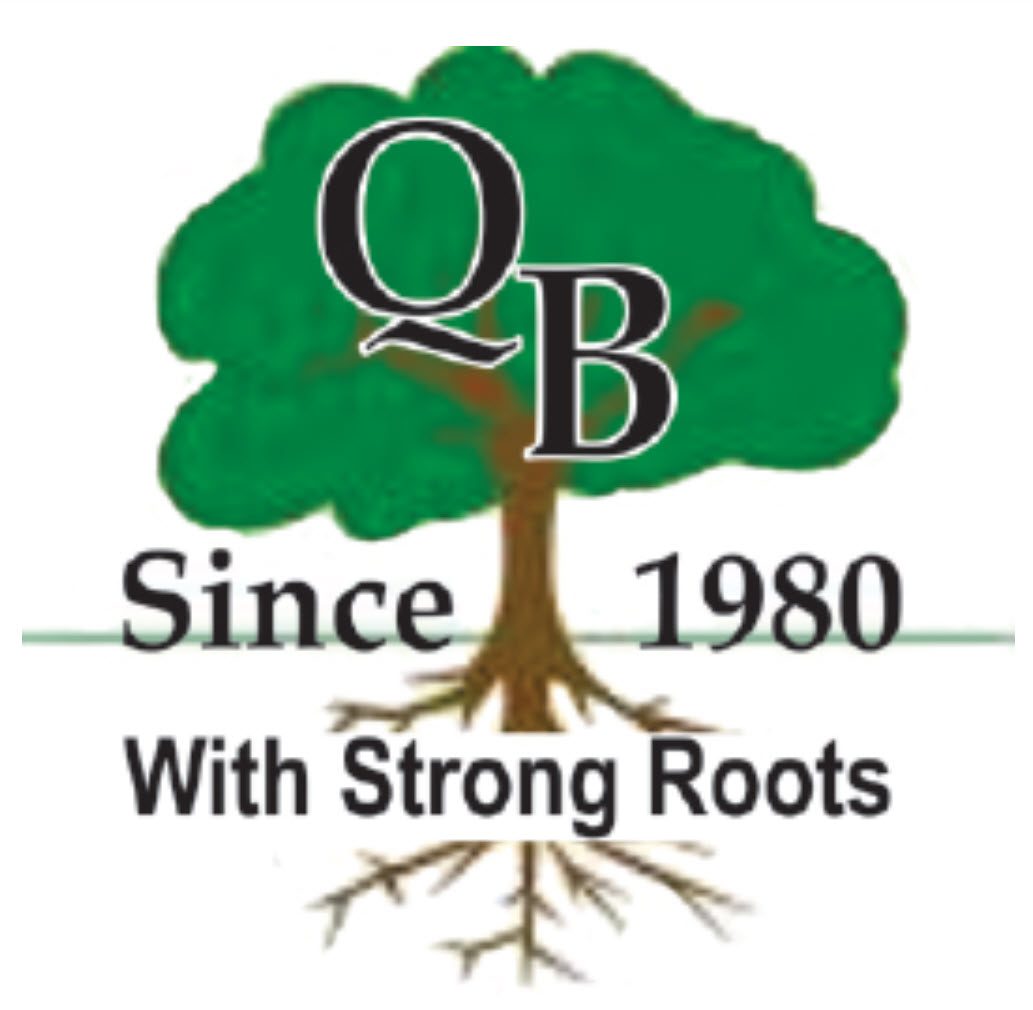- Merry Christmas
- Silent No More
- Solving Cemetery Problems
- British Home Children
- Doors Open 2013 at the Quinte Genealogical Centre
- Why Can’t I Find It Online?
- What’s New in Genetic Genealogy?
- OGS Region 7 General Meeting
- Researching in Scotland
- Tracking the Loyalists
- Hints & Tips for Users of Family Tree Maker
- The Crouse-Wanamaker Lecture (Historic Hastings)
- Writing Your Family History
- Beginning Your Family History
- Doors Open 2012 at the Quinte Genealogy Centre
- 2019 News
- 2018 News
- 2017 News
- 2016 News
- 2015 News
- 2014 News
- 2012-2013 News
- 2011-2012 News
- 2010-2011 News
- 2009-2010 News
- 2008-2009 News
- 2007-2008 News
- 2006-2007 News
- 2005-2006 News
Merry Christmas and Happy New Year!!
The Quinte Branch Executive
Photography by Georgette Green
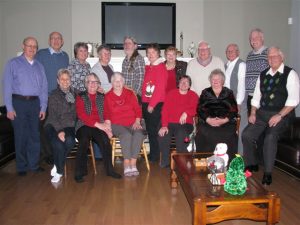
Standing L-R: Bob Dawes, John Carew, Sue Carew, Mary Culloden, Peter Johnson, Sharron Buttler, Carole Foshay, Larry McQuoid, Rodney Green, Terry Buttler
Seated L-R: Georgette Green, Barbara Dawes, Lois Duggan, Angela Johnson, Clare Westheuser, Duane Foshay
Silent No More: Researching Canada’s War Dead 1885-1945
Article by John Carew
Photography by Georgette Green
It was our final presentation, held on November 16th, to cap off the 2013 series of genealogical lectures for Quinte Branch OGS members and guests. Glenn Wright, currently from Ottawa, has ties to Ancestry.ca and is the current President of the British Isles Family History Society of Greater Ottawa. Glenn is an experienced lecturer and several times published author on this subject and others.
The attentive audience was looking for tips and insight into the sometimes difficult tasks of researching family military history, and they were not disappointed. Approximately 45 attendees were treated to a thorough rendition of Canada’s War Dead research opportunities covering the period 1885 to 1945. The talk highlighted some of the key features of researching since Confederation with attention to the Northwest Rebellion circa 1885, the South African War of 1899-1902, and World Wars 1 and 2.
The South African War was the first time that Canada sent large numbers of troops abroad, about 7000 including nurses. The Canadian Contingent war dead are recorded in the South African War/Nile Expedition Book of Remembrance. Additional records can be found in the South African Constabulary (SAC) records for several hundred Canadians who volunteered to help keep the peace in South Africa after the conflict through the period 1900-1908.
The two World Wars garnered the most attention by the presenter and the audience, owing to the size of the conflicts, the number of deaths, the complexity of burials and commemorations in cemeteries and memorials. Today there are several well-known memorials such as Vimy Ridge and Beaumont Hamel in addition to the Menin Gate Memorial, and many others, which are dedicated to the missing with no known graves from WW1. Add to that, hundreds of Cemeteries throughout Europe where thousands upon thousands of war dead from both sides of the two conflicts are interred and documented for posterity.
The variety of information available includes service records, War diaries, circumstances of death registers, and war graves registers. In addition, Books of Remembrance are also available online, as well as regimental histories, honour rolls and there are numerous war memorials in almost every community here in Canada. The internet has made provision of and searching for information about our fallen heroes and family members all the more easy to present and collate.
It was not an accident to have Glenn Wright speak to us this fall on this subject. As we approach the 100th Anniversary of the beginning of WW1 and the 75th Anniversary of the beginning of WW2, our minds and sentiments will surely be aimed in that direction and at the lives of our family members who gave everything. To prove the point, I spent a few minutes following up on my Grand Uncle, Robert Carew, who was killed at Passchendaele in 1917. I was able to add three times the amount of information I had already recorded about him and his part in the war, using mainly the Library and Archives Canada and Veterans’ Affairs websites. Good luck with your own research!
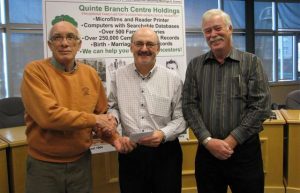
Glenn Wright is thanked by Chair John Carew and Vice-Chair Terry Buttler
Solving Cemetery Problems: Vandalism, Abandoned Cemeteries, Registration and Heritage Designation
Article by John Carew
Photography by John Carew and Georgette Green
On Saturday, October 19, 2013, the Quinte West Council Chambers were filled to capacity to hear Diane Clendenan and Marjorie Stuart from Toronto speak to us on the Ontario Genealogical Society perspective on the status of Ontario cemeteries, the dilemma of having lost track of and fallen behind in the preservation of some of our ancestral history, and the processes and efforts in motion to rectify the situation and reclaim our heritage. Prior to their presentation, Quinte Branch OGS took the opportunity to update the audience on our membership situation of 308 individual members for 2013 and to officially and publicly transfer ownership of some important historical documents to two of our sister organizations in the community.
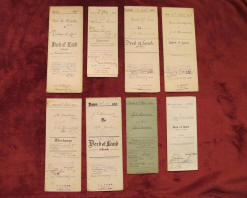 |
 |
At the September Quinte Branch OGS Executive Committee meeting, a number of documents were approved for donation, respectively to the Campbellford-Seymour Heritage Society and to the United Empire Loyalists’ Association of Canada, Bay of Quinte Branch. In the first instance, the documents consisted of 8 historical Deeds and Mortgages for a property situated in the Village of Campbellford, Northumberland County, covering the period 1885 to 1929. The package of old property records was surely saved from oblivion this summer by Quinte Branch Executive Committee members, Debbie McDonald and Debb Walker when purchased by them at a local auction. The first Deed in the set dated 1885 transferred title from Milo Adin Hawley to Mrs. Catherine Lane. On hand to take possession of the documents was Ann Rowe, a former chair of Quinte Branch OGS and the current Past President of the Campbellford Seymour Historical Society.
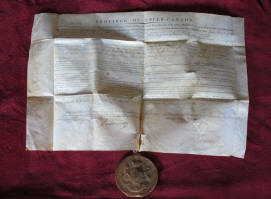 |
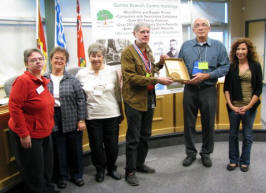 |
Following, a Land Patent document for the East Half of Lot 17, Concession 5, Township of Murray, granting title to Isaac DeMille, a United Empire Loyalist of the Township of Sophiasburg, Prince Edward County, Midland District, dated 17 May 1802, and signed into effect by Peter Hunter Esquire, Lieutenant Governor of the Province of Upper Canada, was presented to the United Empire Loyalists’ Association of Canada, Bay of Quinte Branch. The Land Patent was entrusted to Quinte Branch earlier this year by Tina Sanders of Toronto on behalf of her mother who had been in possession of the Land Patent for a number of years. Tina and her family were originally from Prince Edward County, and she has UEL family history flowing from the Cronk and Sanders families. On hand to receive the Land Patent was Peter W Johnson UE, Past Chair of Quinte Branch OGS and the current President of the UEL Association Bay of Quinte Branch. In their acceptance remarks, both Ann and Peter acknowledged their appreciation for the donations to their respective groups, and applauded the ongoing level of cooperation and mutual support amongst the various member organizations of our local genealogical and historical community.
During the introduction of our guest speakers, Diane Clendenan and Marjorie Stuart, Co-Chairs of the Joint Ontario Genealogical Society and Ontario Historical Society Cemetery Preservation Committee, and of specific interest, the Cemetery Registration Project, the Chair of Quinte Branch OGS took the opportunity to highlight and acknowledge a number of recent local initiatives in the restoration of cemeteries and burial monuments. These included, inter alia, City of Belleville restoration work at the Jones Cemetery and others in
Thurlow Township in the interest of public safety and heritage preservation carried out by Campbell Monument Company of Belleville, an award from the City of Prince Edward County earlier this year to Hugh Heal of MAGRC/7th Town Historical Society for his individual efforts to repair, restore and upright over 500 monuments in the County, the personal efforts of Betty La Rue and Marg Asselstine to make improvements to the Plainfield Cemetery in Thurlow Township as reported in the Belleville Intelligencer earlier this month, and many individual achievements such as the repair, restoration and uprighting of the Reuben White/Esther Marsh monument in White’s Cemetery.
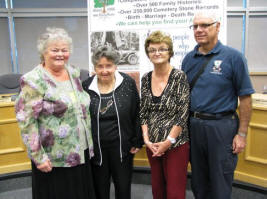 |
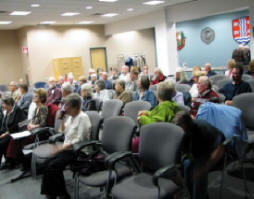 |
Speaking in tandem, Diane and Marjorie gave a spirited and detailed account of the status of the extensive cemetery inventory throughout the Province of Ontario, estimated at close to 10,000 individual sites, of which approximately only 6,000 are registered with the Government of Ontario. Registration, as pointed out, is a critical first step towards ensuring that a cemetery has official standing with government and is protected from development initiatives which otherwise might mean the end to part or all of a cemetery.
Registration is an ongoing project of OGS/OHS and deserves our full understanding and support of its importance. Their talk also covered the not so pleasant reality that by means of vandalism, discontinued management of old cemeteries, neglect of various kinds and the high cost of professional assistance to restore burial monuments to their
former glory, many cemeteries around the province are regrettably showing more than their fair share of damage, dysfunction and disarray. Individual efforts to rectify specific situations, while laudable, are not nearly enough to put everything right, and the shortfall, which is considerable, does not always have an advocacy support group or individual with either private or public funding to bridge the gap. Many examples of horror stories and successes were highlighted, and the Q&A which followed explored even more, and
clearly showed the interest and concern of the audience. Following the meeting, refreshments were enjoyed while those in attendance visited and were able to peruse the Quinte Branch and Clendenan and Stuart sales tables. On hand for the afternoon was Steve Clendenan, VP Finance OGS. On this occasion, Steve was riding shotgun on the trip from Toronto, and helping out with book sales.
British Home Children
Article by John Carew
Photography by Cheryl Levy
On Saturday, September 21, the fall
session of family research lectures sponsored by Quinte Branch OGS was kicked off at the Quinte West Council Chambers. Our guest speaker was Sandra Joyce from Toronto, author of the book “Street Arab” in its third printing, who spoke to an attentive audience on the Home Children saga, blending some of the historical realities of this period with this particular event of social engineering in Canada and a not so sweet rendition of the darker side of the Home Children experiences. The approximate 120,000 Home Children, orphans and destitute children from the British Isles, were mainly indentured to farm and domestic service in Canada until their eighteenth birthdays and then released into society to fend for themselves. On balance, while there were good, bad and neutral outcomes of just how correctly or incorrectly these children were treated during the period of 1869-1939, many of the stories were about treatment that most of us today would consider without hesitation, less than ideal.
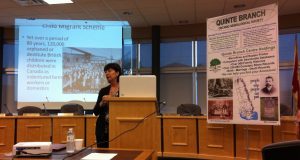
The question period following Sandra’s evocative, personal and effective presentation was equally enjoyable and equally personal. After the presentation, sales of her autographed book “Street Arab” were brisk and plentiful. You can keep track of Sandra’s activities and the British Home Children on her website, http://www.sandrajoyce.com/.
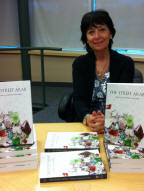
Sandra is the Director of the British Home Child Advocacy and Research Group.
She is also the daughter of a Home Child.
If you are interested in information about the OGS British Home Child – Special Interest Group, please visit their website.
Doors Open 2013 at the Quinte Genealogical Centre
Article by John Carew
Photography by John Carew
On Saturday, September 14, Quinte Branch played host to Doors Open in the Quinte Genealogical Centre, as part of the Quinte West “Doors” initiative. From 10 am to 4 pm,
there was a steady stream of the curious, friends of OGS members, current members, and some potential new members who were thinking of starting a family history project, or were in the early stages of discovering their past. A number of Quinte Branch volunteers were on hand to answer questions, explain the roles and function of Quinte Branch and OGS, and show how to use our library research resources. Of particular note, one couple with a family tree in progress discovered Quinte Branch for the first time and spent a good part of the day working on the computer databases to find numerous relatives connected to the De Mille family. Perhaps membership in OGS and Quinte Branch will be the logical outcome for them.
Everyone who attended went away with our goody bag of pamphlets and tools to encourage and interest them in genealogy and family research. I trust our guests found the day as informative and worthwhile as much as our volunteers found the time enjoyable and rewarding.
Thank you to volunteers Debb Walker, John Carew, Terry and Sharron Buttler, Carole Foshay, Clare Westheuser and Lois Duggan, who made the day a success.
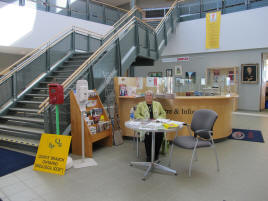 |
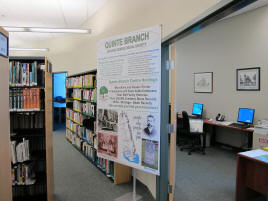 |
Welcome to Doors Open 2013 at Quinte West Public Library and Quinte Genealogy Centre
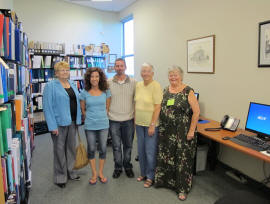 |
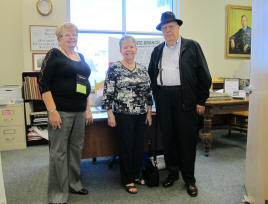 |
Carole, Lois and Claire with DeMille descendants…Carole Foshay with Bernie and Gayle Desjardins
Why Can’t I Find It Online
Article by Bob Dawes
Photography by Georgette Green
The Quinte West council chamber was filled on Saturday, June 15th to celebrate Quinte Branch’s 33rd birthday, and listen to Ruth Blair‘s presentation: “Why Can’t I Find It Online.” Ruth started her presentation with a review of the easy items that can be found on the most popular websites, and then delved into some of the more mundane ways to find your missing pieces. She explained that not everything is online and some research requires a visit to the archives or library, but that you can get leads online as to where it is located. An example would be the English and Welsh vital statistics certificates, which can easily be found indexed on FreeBMD, but require an order from the General Registry Office to obtain the certificate by mail. The same goes for country and local archives where you can search their catalogs online, but must order the documents for delivery by mail.
Ruth reminded us how important it is to join the genealogy societies from where your ancestors originated. They can provide a wealth of information on how to do local research, including obscure websites that might have what you’re looking for freely available. I know that I have discovered this in Cambridgeshire, where their burials are all listed on their website for free. Also, the Manchester FHS has a Scottish Marriage Index that covers Scottish marriages worldwide.
Finally, if you want more information, you can follow Ruth on Facebook by looking for Blair Archival Research or on her blog The Passionate Genealogist.
The meeting closed with refreshments and a birthday cake.
Important websites:
Second Heir and Devisee Commissions Case Files
Canadian War Museum
Campbell Divorce blog
National Archives of Scotland
Archives and Local History Manchester Central Library
FreeBMD
General Register Office England & Wales
Contact Ruth Blair, PLCGS:
The Passionate Genealogist
Blair Archival Research
Blair Archival Research on Facebook
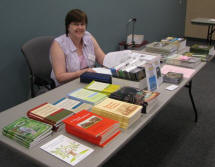 |
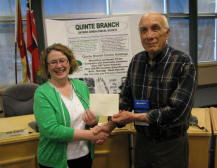 |
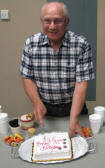 |
| Quinte Branch Publications Booktable | Ruth Blair is thanked by Chair John Carew | QB 33rd Birthday |
What’s New in Genetic Genealogy
Article by Bob Dawes
Photography by Georgette Green
Quinte Branch celebrated the Victoria Day weekend by inviting Dr. John D. Reid to update local genealogists on what’s new with DNA research. He provided the audience with a review of the differences between Y, mitochondrial and autosomal DNA and how they’re used to determine genealogical ancestry. John reviewed the various providers along with their respective costs and benefits. The companies reviewed were Family Tree DNA, 23andMe, Ancestry DNA and National Geographics. Ancestry is not available in Canada yet, although he indicated that he has been promised by Ancestry.ca that it is coming later this year. The National Geographic’s Genographic Project only provides deep ancestry and not connections between relations. Family Tree DNA and 23andMe were the only options for personal tests that provide information about possible relatives, plus your deep ancestry locations. Family Tree DNA‘s Family Finder kit is $199 plus $20 shipping, although they do have frequent sales, while 23andMe’s equivalent kit is $99 with shipping at $60, although they do offer a 20% discount on multiple kits, and a further discount on multiple shipping. 23andMe offers the added benefit of providing your susceptibility to a variety of health issues. The presentation was followed by a lively discussion.
Websites for further research:
www.familytreedna.com
www.23andme.com
www.dna.ancestry.com
genographic.nationalgeographic.com
www.isogg.org
www.yourgeneticgenealogist.com
Check out Dr. John D Reid’s blog:
Anglo Celtic Connections
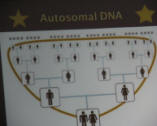
Autosomal DNA Analysis by 23 and Me
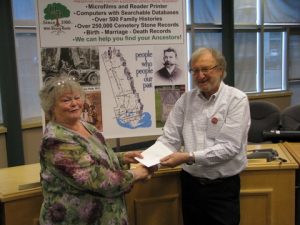
Clare Westheuser thanks Dr. John D Reid for his informative presentation
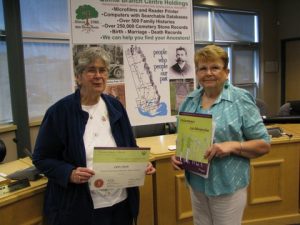
Volunteer Service Awards: Lynne Heale (10 yr) and Carol Foshay (10 yr)
Missing: Tina Gemmel (10 yr), Robin Edison (5 yr)
April Meetings
Article by Bob Dawes
Photography by Georgette Green
On Saturday, April 20th, Quinte Branch hosted the annual OGS Region 7 Meeting at Christ Church in Glen Miller. Although the weather refused to cooperate, there were 31 members in attendance from Quinte, Kawartha and Durham branches.
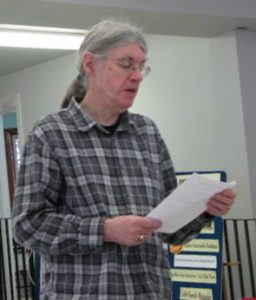
Quinte Branch Report given by Peter Johnson UE, Past Chair
The morning program included welcoming remarks from Region 7 Director, Carole Foshay and annual reports were given from the three branches. Nomination and appointment of a new Region 7 secretary went to Janice Carter.
Next was a presentation from OGS Vice-President, Mike More, on the results of the Governance Committee Report. This is accessible from the members-only section of the OGS website. Comments on its recommendations are welcomed. Mike reported that it is too late for the recommendations to be implemented by this year’s Conference, so they are being planned for the 2014 AGM.
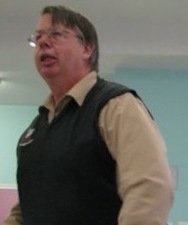
Mike More, OGS Vice-President
Lunch was provided by members of the church, following which several additional people joined the group for the afternoon.
Researching in Scotland: The Lowlands & the Borders
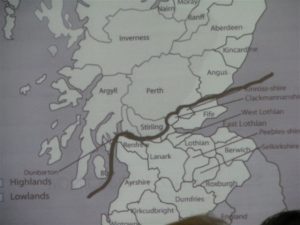
Separation of Highlands & Lowlands
The lecture was presented by Sher Leetooze on her researching experience in Scotland. Sher reviewed the lowland and border counties of Scotland, including their parish structure, geography and local points of interest. She shared highlights about various record repositories available, as well as occupations one would expect to find in that region based on the local industries and landscapes. More detailed information is available in Sher’s book by the same name.
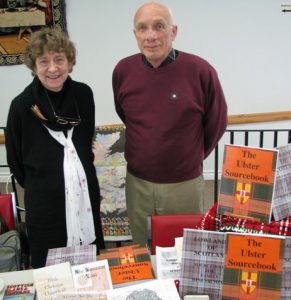
Sher Leetooze & John Carew, Chair
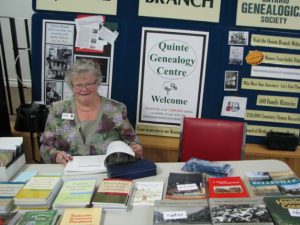 |
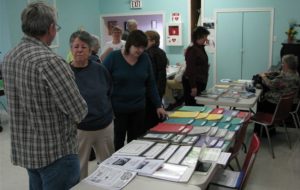 |
| Clare Westheuser at Quinte Branch table | Branch publications and other resources |
Tracking the Loyalists
Article by Bob Dawes
Photography by Deb Walker and Lynn Heale
The Quinte West Council Chamber was filled to capacity to hear acclaimed Canadian editor, author and journalist, Peter C. Newman, speak about his new work in progress called “Hostages to Fortune”, which is about the United Empire Loyalists.
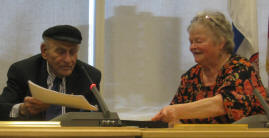 |
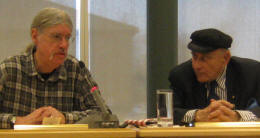 |
Peter C. Newman was welcomed by Programme Coordinator, Clare Westheuser and greeted by Past Branch Chair and Loyalist re-enactor, Peter Johnson UE.
Mr. Newman read excerpts from his book and then filled in the details regarding this time period. He was able to weave the big picture of world politics and current wars into the world of daily life for the transplanted Loyalists. He explained that the Revolutionary War was really the first American Civil War and that the fighting was ferocious and dirty, with people regularly changing sides depending on who was winning. When it was all over, somewhere between 50,000 and 100,000 people left their homes and businesses in the American Colonies to begin a new life in the wilderness of Canada. One flotilla of emigrant refugees from New York had over 140 ships, which in comparison, is bigger than the Spanish Armada. These newcomers completely overwhelmed the inhabitants and scattered throughout their adopted country, and completely changed it. They and their descendants rightly deserve their UE heritage designation for giving us the Canada we know today, and for saving it from domination by the new nation of the United States.
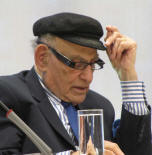 |
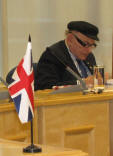 |
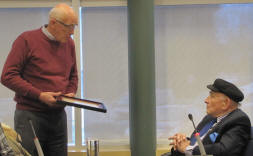 |
After his presentation, Peter C. Newman was presented with an honorary membership by Quinte Branch Chair, John Carew.
Hints & Tips for Users of Family Tree Maker
Article by Bob Dawes
Photography by Georgette Green
The Quinte West Council Chamber had a full house to hear Rick Roberts presentation on Family Tree Maker 2012 software. Both Rick and his wife, Sandra, had brought a little of their Global Genealogy store with them and their sales tables were busy with eager customers both before and after the presentation.
 |
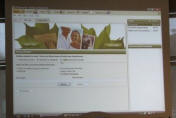 |
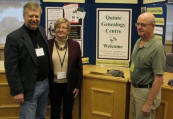 |
Rick’s presentation concentrated on the latest offering from Ancestry: Family Tree Maker 2012. You can upgrade to this product directly from older versions of Family Tree Maker, Legacy, PAF and The Master Genealogist. All others require a GEDCOM file import. Unlike previous versions, this product does not change your original file so you can easily go back and forth between versions, although any changes in FTM2012 won’t be reflected in any earlier version or other program. On the synchronization issue, FTM2012 allows you to work seamlessly between computers, tablets and smartphones. Rick used the example of snapping a photo of a tombstone while on business in downtown Toronto and having the update on his desktop when he got home. To make this work properly, you must have the free
Ancestry app installed on your smartphone or tablet. The web syncing feature allows a selection of privacy choices so you can go from complete sharing of your data with the world to just using the feature for personal backup security. The main menu bar looks significantly different from previous versions and other genealogy products with tabbed choices for PLAN, PEOPLE, PLACES, MEDIA, SOURCES, PUBLISH and WEB SEARCH. For a complete review of all its features and a comparison to other popular products, click here. Some of the features that impressed me were the linking of images from their source location, so your pictures are not stored in the program file, and the ability to globally edit sources, places and media without needing to access the individuals they are associated with. This product is definitely worth a look and can be obtained from Global Genealogy.com under the software tab. FTM for Mac 2 (v. 2012) is also available. Both can be downloaded directly from the Global site for those who are impatient to try it.
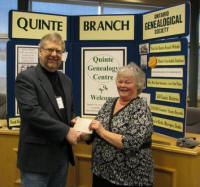
Branch Programme Coordinator, Clare Westheuser thanked presenter Rick Roberts,
of Global Genealogy for his very detailed and informative presentation.
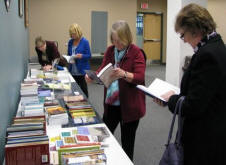
Global Genealogy book table
The Crouse-Wanamaker Lecture
(Historic Hastings)
Article by Bob Dawes
Photography by Georgette Green
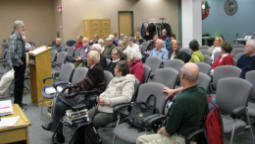
The Quinte West Council Chamber was filled with a lot of new faces as the branch kicked off its 2013 season with the annual Crouse-Wanamaker lecture.
The new executive committee was introduced and ratified by the members in attendance and these are:
John Carew – Chair
Vacant – Vice Chair (however, we are hopeful that this will be filled soon)
Debbie McDonald – Secretary
Larry McQuoid – Treasurer
Other new volunteers noted at the meeting were Cheryl Levy (Webmaster), Debb Walker (Publicity) and Lillian Wannamaker (Newsletters Archive). There are still positions open for various branch projects, so if you are interested, don’t hesitate to contact any member of the executive committee to find out more. One of these is the position of branch librarian, so if you have any skills in this regard, or would like to learn them, please volunteer. Marilyn Harry introduced the Crouse-Wanamaker Lecture by explaining the history of the branch and its founding members Gordon Crouse, Loral Wanamaker and Mildred Wanamaker. Bob Dawes then introduced the speaker, Hastings County Historian Emeritus, Gerry Boyce.
Gerry regaled the audience with stories taken from his new book, Historic Hastings – Volume Two. The original was prepared for the Canadian Centennial in 1967 and is almost 50 years out of date and a lot has changed in Hastings County since then. In addition to the new volume, the original is also being reprinted with an enlarged introduction and a new index, which includes all names found in the book. A boon for genealogists. Since the new book will be almost 300 pages, Gerry gave the audience a chance to ask questions on their areas of interest, which he answered from his draft copy. These included subjects like area sports other than hockey, the Tibetan enclave, boundary changes, First Nations and more.
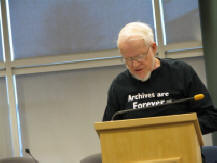 |
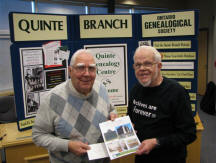 |
Larry McQuoid, Treasurer, with Historian and Author, Gerry Boyce.
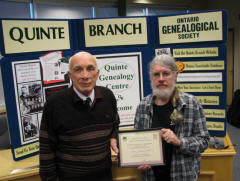
Incoming Chair, John Carew, wrapped up the meeting by presenting Peter Johnson UE with a certificate honouring his three years as Quinte Branch Chair.
Writing Your Family History
Article by Bob Dawes
Photography by Georgette Green
Quinte Area genealogists gathered in the Quinte West Council Chambers to hear speaker, Harry van Bommel, talk about the Canada 150 Project. This aims to record as many personal stories as possible for Canada’s 150th birthday in 2017 and it isn’t too early to start. In fact, Harry challenged everyone in the room to identify forty stories they would like to pass on to their children and grandchildren. He suggested that we write ourselves a one-page letter about each topic and aim to complete them by Christmas 2013. Those forty pages, along with related photographs and other clippings could easily result in a book of 150 to 200 pages.
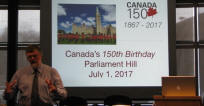 |
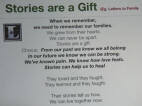 |
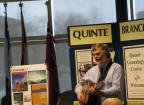 |
Harry explained that the Boomer generation, and the ones that have followed it, have not recorded their history in the same way as their ancestors did. We do so much by email and with digital cameras, which is all saved on our computers. He also pointed out that our children, who inherit our memorabilia, are very mobile and will likely have lost it by their third or fourth house move. Therefore, it is especially important that we record whatever we want to say to the future generations in our families. The Canada 150 Project aims to help anyone to do this with printed guides, a website and a blog. The website is located at http://www.canada150.com, where you can download and print the guides or the whole e-book. Paper copies are also available for sale from the same website. Ultimately, your family stories recorded on paper will reside in Library & Archives Canada, or will be preserved digitally through http://www.canadiana.org, so that they aren’t lost to future generations.
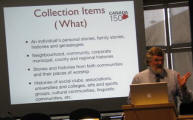 |
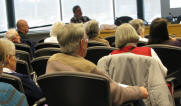 |
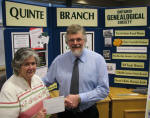 |
Lynn Heale, Membership Coordinator, thanked Harry van Bommel for sharing his inspiring presentation.
Beginning Your Family History
Article by Bob Dawes
Photography by Georgette Green
What better way to spend a dismal fall afternoon than to re-energize yourself to attack your genealogy brick walls over the coming winter. On Saturday, October 20th, thirty-six area members and guests gathered in the Quinte West Town Hall to hear Claire Nabrotzky speak on how to begin your family history search. As she pointed out repeatedly, we all succumb to the same poor practices such as, not documenting where we find information, so it was refreshing to go back over the basics, even for the experienced genealogists in the room.
Claire’s presentation was organized into three parts:
No. 1 Gather Information: Search out and accumulate all of the family records you can find, from the official vital records to the obscure family cookbooks, which may contain photos and memories.
No. 2 Record Information: Take advantage of the free software programs and standard genealogy forms available online to log your research, starting with the basic pedigree chart and family record sheet. Record your information using more than one method, so that you have a back up of your information. A new form that I hadn’t seen before was the Family Heirloom Inventory, which records who in your family has items from your ancestors.
No. 3 Start with One Person: Set an objective using known facts to make a hypothesis, and then set about proving it in an organized way, recording everything as you go. A spirited question and answer session followed with many in the audience receiving directions about what to do next. Some helpful suggestions included:
Top Software | Free Software | Free Forms | Self Help
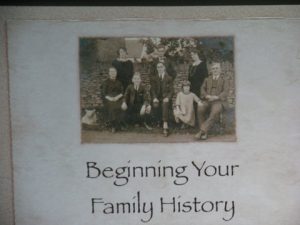 |
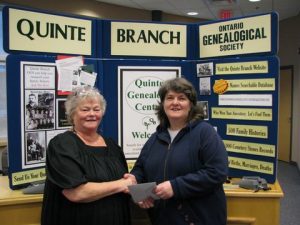 |
Branch Secretary, Clare Westheuser thanked presenter Claire Nabrotzky for her informative presentation.
Doors Open 2012 at the Quinte Genealogy Centre
Article by Bob Dawes
Photography and captions by Stacy Goddard
On Saturday, September 15th, Quinte Branch participated in the Doors Open event in Quinte West. There was a steady stream of visitors throughout the day who were interested in getting started on their family trees or how to overcome roadblocks in their research. Serendipity struck when a couple from Seattle ran into a cousin staying at the same hotel in Napanee. Many branch volunteers were on hand to provide one on one assistance. The most common question was about Home Children with many people trying to trace them to their origins in England or track down other siblings in North America. All the computers were constantly busy with many using the CemSearch database, the Names Index Finding Aid and library catalog requests. Most visitors were genuinely surprised that they could use the branch research library any time the Quinte West Public Library is open. Goody bags were handed out containing maps, cemetery locations, branch information and a Quinte West pin. From a personal perspective, I think that the biggest benefit was for many of the volunteers who learned more about how our library functions and how to use its resources.
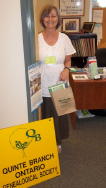
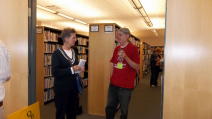 |
 |
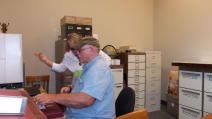 |
 |
Quinte Branch volunteers Peter Johnson, Stacy Goddard, Bob Dawes, Barbara Dawes, Mary Culloden, Marilyn Harry, Clare Westheuser and Lois Duggan greeted
genealogically motivated guests with goody bags and helped them to better understand and use the library resources.
